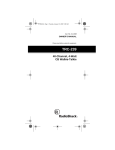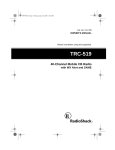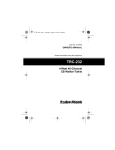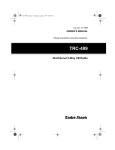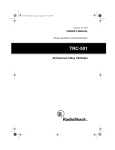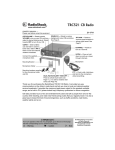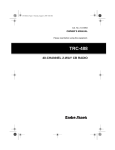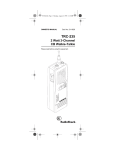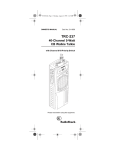Download Radio Shack 310 Owner`s manual
Transcript
21-1678.fm Page 1 Thursday, August 5, 1999 12:45 PM Cat. No. 21-1678 OWNER’S MANUAL Please read before using this equipment. TRC-234 5-Watt, 40-Channel CB Walkie-Talkie with 10 Weather Channels 21-1678.fm Page 2 Thursday, August 5, 1999 12:45 PM FEATURES Your Radio Shack TRC-234 5-Watt 40-Channel CB Walkie-Talkie is a high performance transceiver that also lets you tune into local and national weather service broadcasts. This CB is perfect for recreational, business, or emergency use. You can call other people who have CBs at home, in their vehicles, or at camp sites. You can also connect optional equipment to your CB, such as external speakers, or a DC power supply and base station antenna to set up a base station in your home. Your CB has the following features: 10-Channel WX Band Receiver — includes seven national and three international weather frequencies. You can hear local conditions and forecasts wherever you travel. LCD Digital Display — lets you see the channel number you select, incoming and outgoing signal strength, and the selected mode (such as Weather, Emergency, etc.) PLL (Phase-Locked Loop) Frequency Synthesizer — provides highly accurate and stable tuning. Two Ceramic Filters — provide superior selectivity and freedom from adjacent channel interference. Hysteresis Squelch Circuit — compensates for fading signals and eliminates signal chopping during reception. Automatic Noise Limiting (ANL) Circuit — reduces noise caused by nearby electrical equipment such as motors or automotive ignition systems. Emergency Channel 9 Switch — lets you quickly switch to Channel 9 so you can report or monitor emergency situations. © 1995 Tandy Corporation. All Rights Reserved. Radio Shack is a registered trademark used by Tandy Corporation. 2 21-1678.fm Page 3 Thursday, August 5, 1999 12:45 PM High/Low Power Button — lets you save power by selecting a suitable transmitting power for long or short distances. For your records, we recommend you record your CB’s serial number here. The number is located on the CB’s back panel. Serial Number _____________________ FCC INFORMATION The Federal Communications Commission (FCC) does not require you to have a license to operate this CB. However, you must know Part 95 of FCC Rules. It explains the proper operation of a Class D citizen’s band transceiver. We enclosed a copy of Part 95 with your CB. Warning: Do not open the CB to make any internal adjustments. A CB is set up to transmit a regulated signal on an assigned frequency. It is against the law to alter or adjust the settings inside the unit to exceed these limitations. Any adjustments to a CB must be made by a qualified technician using the proper test equipment. To be safe and sure: • Never open your CB’s case. • Never change or replace anything in your CB. Your CB might cause TV or radio interference even when it is operating properly. To determine whether your CB is causing the interference, turn it off. If the interference goes away, your CB is causing it. Try to eliminate the interference by: • Moving your CB away from the receiver • Contacting a radio/TV technician or your local Radio Shack store for help If you cannot eliminate the interference, the FCC requires that you stop using your CB. This device complies with Part 95 of FCC Rules. Operation is subject to the following two conditions: 3 21-1678.fm Page 4 Thursday, August 5, 1999 12:45 PM 1. This device must not cause harmful interference. 2. This device must accept any interference received, including interference that may cause undesired operation. CONTENTS Preparation ........................................................... 6 Connecting Power ........................................... 6 Using Internal Batteries ............................ 6 Using Vehicle Battery Power .................... 8 Using Standard AC Power ....................... 9 Charging Nickel-Cadmium Batteries ............. 11 Connecting an Antenna ................................ 12 Using an External Speaker ........................... 13 Using an External Speaker/Microphone ........ 13 Using the Wrist Strap .................................... 14 Using the Belt Clip ......................................... 14 Operation ............................................................ Receiving Transmissions and Adjusting Squelch .................................. Transmitting .................................................. Turning On/Off the Light ................................ Locking the Functions ................................... Using Channel 9 ............................................ Listening to the Weather Band ...................... 15 Operational Hints ............................................... Common Uses for a CB ................................ Business Uses ....................................... Personal Uses ....................................... Transmission Courtesy ................................. Maximum Range ........................................... Using Common 10-Codes ............................. Channel Assignments ................................... 20 20 20 20 21 21 21 23 15 16 17 18 18 19 Care and Maintenance ....................................... 25 Specifications ..................................................... 26 4 21-1678.fm Page 5 Thursday, August 5, 1999 12:45 PM PREPARATION CONNECTING POWER You can power your transceiver from any of three sources: • Internal batteries (not supplied) • Vehicle battery power (using an optional DC cigarette lighter power cord) • Standard AC power (using an optional DC power supply) Note: Connecting a DC power cord automatically disconnects internal batteries. Using Internal Batteries You can power your transceiver with nine AA batteries. For the longest operation and best performance, we recommend alkaline batteries (such as Cat. No. 23-552). Or, you can use rechargeable nickelcadmium batteries (Cat. No. 23-125). Follow these steps to install or replace batteries. 1. If the transceiver is on, turn VOLUME/OFF counterclockwise until it clicks to turn it off. 2. Remove the battery compartment cover by sliding it in the direction of the arrow. illustration 3. Remove any old batteries from the compartment. Cautions: • Always dispose of old batteries promptly and properly. 5 21-1678.fm Page 6 Thursday, August 5, 1999 12:45 PM • Never leave dead, old, or weak nonrechargeable batteries in the transceiver. They can leak chemicals and corrode or damage electronic circuits. • Do not expose batteries to extreme heat or fire. They might explode and cause personal injury or damage equipment. 4. Position the NI/AL switch to match the battery type. • NI: for rechargeable nickel-cadmium batteries (see “Charging Nickel-Cadmium Batteries”). • AL: for standard or alkaline batteries. illustration 5. Install nine fresh non-rechargeable batteries or nine nickel-cadmium batteries as indicated by the polarity symbols (+ and –) marked inside the battery compartment. illustration Cautions: • Improper installation (incorrect polarity) might damage the transceiver. • Use only fresh batteries of the required size and type. Never mix new and old batteries or rechargeable and non-chargeable batteries in the transceiver. 6 21-1678.fm Page 7 Thursday, August 5, 1999 12:45 PM • If you do not plan to use batteries in the transceiver for a month or more, remove the batteries. This protects the transceiver from possible battery leakage. 6. Replace the cover. When BATT (battery low) appears on the display, replace or recharge the batteries. Using Vehicle Battery Power You can power your transceiver from your vehicle’s cigarette lighter socket with an optional DC cigarette lighter power cord (such as Cat. No. 270-1534). Cautions: • You must use a DC power cord that supplies 12 volts and delivers at least 2.5 amps. Its center tip must be set to positive, and it must have a plug that properly fits your transceiver’s DC13.8V CHARGE jack. The recommended power cord meets these requirements. Using a power cord that does not meet these specifications could damage the transceiver or the power cord. • To protect your vehicle’s electrical system, always plug the power cord into the transceiver before you plug it into your vehicle’s cigarette lighter socket. Always unplug the power cord from the vehicle’s cigarette lighter socket before you unplug it from the transceiver. illustration 1. Insert the power cord’s barrel plug into the transceiver’s DC13.8V CHARGE jack. 2. Plug the other end of the cord into your vehicle’s cigarette lighter socket. 7 21-1678.fm Page 8 Thursday, August 5, 1999 12:45 PM Notes: • If you installed rechargeable nickel-cadmium batteries in the transceiver, connect the DC power cord to the DC13.8V CHARGE jack and be sure the NI/AL switch is set to NI. This powers the transceiver and recharges the batteries at the same time. See “Charging NickelCadmium Batteries.” • If the transceiver does not operate when you use the power cord, unplug the cord from the cigarette lighter socket and clean the socket to remove ashes and debris. If it still does not operate properly, check the in-line fuse in the power cord. Using Standard AC Power You can operate the transceiver from AC power using a 12-volt DC power supply (such as Cat. No. 22120, not supplied), a DC cigarette lighter power cord (such as Cat. No. 270-1534, not supplied), and a cigarette lighter accessory outlet (such as Cat. No. 2701539, not supplied). Cautions: • You must use a DC power cord that supplies 12 volts and delivers at least 2.5 amps. Its center tip must be set to positive, and it must have a plug that properly fits your transceiver’s DC13.8V CHARGE jack. The recommended power cord meets these requirements. Using a power cord that does not meet these specifications could damage the transceiver or the power cord. • Be sure you connect the DC power cord to the transceiver before you connect it to the power supply. Then disconnect the power cord from the power supply before you disconnect it from the transceiver. Note: Most 12-volt DC power supplies plug into a standard AC outlet to produce DC power. Before connecting your transceiver to a 12-volt DC power supply, read and follow the instructions included with the power supply. 8 21-1678.fm Page 9 Thursday, August 5, 1999 12:45 PM Follow these steps to power the transceiver from AC power. 1. Using the double-sided foam tape supplied with the cigarette lighter accessory outlet, mount the accessory outlet to the DC power supply. 2. Insert the power cord’s barrel plug into the transceiver’s DC13.8V CHARGE jack. Note: If you installed rechargeable nickel-cadmium batteries in the transceiver, connect the power cord to the DC13.8V CHARGE jack and be sure the NI/AL switch is set to NI. This powers the transceiver and recharges the batteries at the same time. See “Charging Nickel-Cadmium Batteries.” 3. Insert the cigarette lighter plug on the DC power cord into the cigarette lighter accessory outlet. 4. Connect the DC power supply to a standard AC outlet. 9 21-1678.fm Page 10 Thursday, August 5, 1999 12:45 PM CHARGING NICKEL-CADMIUM BATTERIES The transceiver has a built-in circuit that lets you recharge nickel-cadmium batteries while they are in the transceiver. To charge the batteries, connect a DC power cord to the transceiver’s DC13.8V CHARGE jack and be sure the NI/AL switch is set to NI (see “Using Standard AC Power” or “Using Vehicle Battery Power”). Warning: Do not connect a power cord to the transceiver’s DC13.8V CHARGE jack if you installed non-rechargeable batteries (standard, extra-life, or alkaline) and the NI/AL switch is set to NI. Non-rechargeable batteries become hot and can even explode if you try to recharge them. It takes about 16 to 18 hours to recharge batteries that are fully discharged. Nickel-cadmium batteries come fully discharged. The first time you use nickel-cadmium batteries, charge them about 18 hours to bring them to a full charge. Notes: • Nickel-cadmium batteries last longer and deliver more power if you occasionally let them fully discharge. To do this, simply use the transceiver until it no longer transmits or receives. • To prevent permanent nickel-cadmium battery power loss, do not charge the batteries at temperatures below 14°F (–10°C) or above 131°F (55°C). • Do not overcharge batteries. Overcharging can severely reduce the battery’s useful life. Important: At the end of a rechargeable battery’s useful life, it must be recycled or disposed of properly. Contact your local, county, or state hazardous waste management authorities for information on recycling or disposal programs in your area. Some options that might be available are: municipal curb-side collection, drop off boxes at retailers, recycling collection centers, and mail-back programs. 10 21-1678.fm Page 11 Thursday, August 5, 1999 12:45 PM CONNECTING AN ANTENNA Your transceiver comes with a flexible rubber antenna that is ideal for most applications. However, the transceiver’s BNC antenna connector makes it easy to connect other types of antennas. Your local Radio Shack store sells a wide variety of antennas. Choose the one that best meets your needs. Follow these steps to connect the supplied antenna. illustration 1. Position the antenna’s BNC connector over the antenna jack on the transceiver. 2. Slip the slot in the antenna connector over the antenna jack’s tab on top of the transceiver. 3. Press down and turn the antenna’s connector clockwise until it locks into place. To use a mobile or base-station antenna, attach an appropriate connector adapter (such as Cat. No. 278-120, not supplied) to the end of the antenna’s cable. Then insert it onto the transceiver’s antenna connector. Warning: Use extreme caution when installing or removing an outdoor antenna. If the antenna starts to fall, let it go! It could contact overhead power lines. If the antenna touches a power line, contact with the antenna, mast, cable, or guy wires can cause electrocution and death! Call the power company to remove the antenna. Do not attempt to remove the antenna yourself. 11 21-1678.fm Page 12 Thursday, August 5, 1999 12:45 PM USING AN EXTERNAL SPEAKER In a noisy area, an external speaker (such as Cat. No. 21-549) positioned in the right place might provide more comfortable listening. Plug the speaker cable’s 1/8-inch (3.5 mm) mini-plug into the transceiver’s SPK jack. This disconnects the internal speaker. illustration USING AN EXTERNAL SPEAKER/ MICROPHONE You can use an external speaker/microphone (such as Cat. No. 19-310). Plug the speaker/microphone’s connector into the transceiver’s MIC and SPK jacks. illustration 12 21-1678.fm Page 13 Thursday, August 5, 1999 12:45 PM USING THE WRIST STRAP You can use the supplied wrist strap to keep the transceiver accessible. Hook the strap’s connecting ring to the tab, as shown. Then simply slip the strap over your hand. illustration USING THE BELT CLIP Use the supplied belt clip to make the transceiver easier to take with you. Use the two supplied screws to attach the belt clip to the transceiver. Slide the belt clip over your belt or waistband. illustration 13 21-1678.fm Page 14 Thursday, August 5, 1999 12:45 PM OPERATION Before you use your transceiver, you should know how to use it effectively and courteously. “Operational Hints” contains information that will help you get more enjoyment from your transceiver. RECEIVING TRANSMISSIONS AND ADJUSTING SQUELCH 1. Turn SQUELCH fully counterclockwise. illustration 2. Rotate VOLUME clockwise until it clicks to turn on the power. A channel number appears on the display. illustration 3. Press CHANNEL s or t to select the desired channel. illustration Note: If you press CHANNEL s when you are tuned to Channel 40, the channel selector returns to Channel 1. If you press CHANNEL t when you are tuned to Channel 1, the channel selector returns to Channel 40. 14 21-1678.fm Page 15 Thursday, August 5, 1999 12:45 PM 4. Adjust VOLUME to a comfortable listening level. 5. To cut out background noise between transmissions, wait until there is no signal on the channel, then slowly turn SQUELCH clockwise until the background noise stops. Note: Do not turn SQUELCH too far clockwise because you might cut out weak signals, too. 6. To turn off the transceiver, turn VOLUME counterclockwise until you hear it click. TRANSMITTING We recommend you try receiving transmissions before you try to transmit. Follow these steps to transmit. 1. Press and hold the talk button. TX appears on the display, and the signal meter on the display shows the output level. Hold the transceiver about 2-3 inches from your mouth and speak slowly and clearly in a normal tone of voice. illustration 2. When you finish transmitting, release the talk button. 15 21-1678.fm Page 16 Thursday, August 5, 1999 12:45 PM 3. If you are transmitting to nearby units, press H/L to set the output power to low output power, if necessary. LOW appears on the display. illustration If the other transceiver is farther away or the receiving person complains of noise, press H/L again to set it to high output power. LOW disappears from the display. 4. To turn off the transceiver, turn VOLUME counterclockwise until you hear it click. TURNING ON/OFF THE LIGHT Press LIGHT to turn on and off the display’s light. If you do not turn the light off manually, the light automatically shuts off in 5 seconds. illustration 16 21-1678.fm Page 17 Thursday, August 5, 1999 12:45 PM LOCKING THE FUNCTIONS Use the KEY LOCK switch to lock the transceiver’s functions (except the talk button and LIGHT) to prevent accidental program changes. Press KEY LOCK so LOCKappears on the display. illustration To release the lock, press KEY LOCK again. LOCK disappears from the display. USING CHANNEL 9 For emergency call monitoring or transmitting on Channel 9, just press CH-9. 9 and EMGappear on the display. illustration Important! Channel 9 is reserved for motorist assistance and for reporting emergency information about accidents, hazardous road conditions, and so on. Always give emergency messages priority on Channel 9. To release the transceiver from Channel 9, press CH9 again. The previously selected channel number appears on the display. Note: The KEY LOCK, WEATHER , and CHANNEL buttons do not work when CH-9 is pressed. 17 21-1678.fm Page 18 Thursday, August 5, 1999 12:45 PM LISTENING TO THE WEATHER BAND The FCC (Federal Communications Commission) has allocated 11 channels for use by the National Oceanographic and Atmospheric Administration (NOAA). NOAA broadcasts your local forecast and regional weather information on one or more of these channels in your area. We have preprogrammed your CB with 10 of the U.S frequencies used by NOAA. See “Channel Assignments.” To select a weather broadcast, press WEATHER then press CHANNEL s or t to choose between the 10 frequencies. WX appears on the display. illustration Press WEATHER again to return to normal CB operation. Note: The H/L and CH-9 buttons do not work when WEATHER is pressed. 18 21-1678.fm Page 19 Thursday, August 5, 1999 12:45 PM OPERATIONAL HINTS Like most activities, CB radio has its customs and courtesies. The following tips will help you get the most enjoyment from your transceiver. COMMON USES FOR A CB Business Uses • Truck drivers and delivery personnel can learn road and traffic conditions and get assistance in locating destinations. A CB is also good company on those “long hauls.” • On construction crews, a CB quickly pays for itself when you are calling for additional materials or coordinating the activities of different work crews. • For security officers, a CB is more than a convenience — it is a must for both safety and efficiency. Personal Uses • Keep in touch with home while driving to work, to the store, or to a social activity. Let your family know you are tied up in traffic or that you will stop by the store on the way home. • If you are a two-car (or more) family, CBs are great for communicating with family members while they are in their cars. • Contact friends or neighbors — find out “what’s happening” or plan a get-together. • Ever have car trouble or run out of gas on the highway? What an assurance it is to be able to call for assistance! • Camping, fishing, and other sports are more fun with a CB. Locate a buddy or find out “what’s cooking” back at camp. 19 21-1678.fm Page 20 Thursday, August 5, 1999 12:45 PM TRANSMISSION COURTESY • Wait for a pause in someone else’s transmission before you ask for a break. • If you do not receive an answer to your call after a second attempt, sign off and wait several minutes before trying again. • Do not hold down the talk button when you are not talking. (This is called dead keying.) • Assist callers with directions, information about road conditions, and any other reasonable requests. MAXIMUM RANGE The maximum range and quality of CB transceiver transmissions vary depending on the following conditions: • The type and quality of antenna used • The height of the antenna’s mounting location — the higher the antenna, the better the signal’s range • The surrounding terrain — mountains and tall buildings limit the range • Weather conditions • The number of nearby CBs operating on the same channel Note: Your transceiver’s transmission range is generally line-of-sight. To ensure maximum range, always keep fresh or fully-charged batteries in your CB. USING COMMON 10-CODES Citizen’s band operators and CB users have largely adopted the 10-codes for standard questions and answers. These codes permit faster communication and better intelligibility in noisy areas. 20 21-1678.fm Page 21 Thursday, August 5, 1999 12:45 PM This table lists codes adopted by the Associated Public Safety Communications Officers (APCO). Code Meaning 10-1 Your signal is bad. 10-2 Your signal is good. 10-3 Stop transmitting. 10-4 Message received and understood. 10-5 Relay information to _____. 10-6 I am busy or are you busy? 10-7 Out of service. 10-8 In service. 10-9 Repeat last message. 10-10 Negative (NO). 10-11 _____ in service. 10-12 Stand by. 10-13 Report road/weather conditions. 10-14 Information. 10-15 Message delivered. 10-16 Reply to message. 10-17 En route. 10-18 Urgent. 10-19 Contact _____. 10-20 What is your location? 10-21 Call _____ by telephone. 10-22 Cancel last message. 10-23 Arrived at the scene. 10-24 Assignment complete. 10-25 Meet _____. 10-26 Estimated time of arrival is _____. 21 21-1678.fm Page 22 Thursday, August 5, 1999 12:45 PM CHANNEL ASSIGNMENTS Your transceiver receives and transmits on the 40 channels listed here. Channel Frequency (MHz) Channel Frequency (MHz) 1 26.965 21 27.215 2 26.975 22 27.225 3 26.985 23 27.255 4 27.005 24 27.235 5 27.015 25 27.245 6 27.025 26 27.265 7 27.035 27 27.275 8 27.055 28 27.285 9 27.065 29 27.295 10 27.075 30 27.305 11 27.085 31 27.315 12 27.105 32 27.325 13 27.115 33 27.335 14 27.125 34 27.345 15 27.135 35 27.355 16 27.155 36 27.365 17 27.165 37 27.375 18 27.175 38 27.385 19 27.185 39 27.395 20 27.205 40 27.405 22 21-1678.fm Page 23 Thursday, August 5, 1999 12:45 PM In addition, your transceiver is programmed with the following weather service channels: Channel Frequency (MHz) 01 162.550 02 162.400 03 162.475 04 162.425 05 162.450 06 162.500 07 162.525 08 161.650 09 161.775 00 163.275 23 21-1678.fm Page 24 Thursday, August 5, 1999 12:45 PM CARE AND MAINTENANCE Your Radio Shack TRC-234 5-Watt 40-Channel CB Walkie-Talkie is an example of superior design and craftsmanship. The following suggestions will help you care for your CB so you can enjoy it for years. • Keep the CB dry. If it gets wet, wipe it dry immediately. Liquids can contain minerals that can corrode the electronic circuits. • Use and store the CB only in normal temperature environments. Temperature extremes can shorten the life of electronic devices, damage batteries, and distort or melt plastic parts. • Handle the CB gently and carefully. Dropping it can damage circuit boards and cases and can cause the CB to work improperly. • Keep the CB away from dust and dirt, which can cause premature wear of parts. • Wipe the CB with a damp cloth occasionally to keep it looking new. Do not use harsh chemicals, cleaning solvents, or strong detergents to clean the CB. Modifying or tampering with the CB’s internal components can cause a malfunction and might invalidate the CB’s warranty, and void your FCC authorization to operate it. If your CB is not performing as it should, take it to your local Radio Shack store for assistance. 24 21-1678.fm Page 25 Thursday, August 5, 1999 12:45 PM SPECIFICATIONS RECEIVER Frequency Coverage ............ 26.965 to 27.405 MHz Sensitivity....................................... 0.5 mV for 10 dB (S+N)/N Adjacent Channel Rejection ............. 60 dB Squelch .................................. Adjustable from 1 mV Audio Output ............................ 400 mW (10% THD) Current Drain Standby .................................................. 55 mA Receive ................................................ 550 mA Note: The transceiver draws an additional 800 mA when charging nickel-cadmium batteries. TRANSMITTER Frequency Coverage ............ 26.965 to 27.405 MHz Power Input ....................................... 5 W (at HIGH) 2.5 W (at LOW) Power Output ................................... 3.8W (at HIGH) 0.8 W (at LOW) Conducted Spurious Emission Harmonics ......................... 60 dB or better Type of Modulation .............................................. A3 Frequency Tolerance ................................... 0.002% Antenna Impedance .................................... 50 Ohm Current Drain HIGH ........................................................ 1.6 A LOW ..................................................... 600 mA Note: The transceiver draws an additional 800 mA when charging nickel-cadmium batteries. Dimensions (HWD) ........... 21/8 ¥ 613/16 ¥ 13/4 Inches (54 ¥ 172.5 ¥ 45 mm) Weight ................................................. 11 oz (318 g) Specifications are typical; individual units might vary. Specifications are subject to change and improvement without notice. 25 21-1678.fm Page 26 Thursday, August 5, 1999 12:45 PM NOTES 26 21-1678.fm Page 27 Thursday, August 5, 1999 12:45 PM 27 21-1678.fm Page 28 Thursday, August 5, 1999 12:45 PM RADIO SHACK LIMITED WARRANTY This product is warranted against defects for 90 days from date of purchase from Radio Shack companyowned stores and authorized Radio Shack franchisees and dealers. Within this period, we will repair it without charge for parts and labor. Simply bring your Radio Shack sales slip as proof of purchase date to any Radio Shack store. Warranty does not cover transportation costs. Nor does it cover a product subjected to misuse or accidental damage. EXCEPT AS PROVIDED HEREIN, RADIO SHACK MAKES NO EXPRESS WARRANTIES AND ANY IMPLIED WARRANTIES ARE LIMITED IN DURATION TO THE DURATION OF THE WRITTEN LIMITED WARRANTIES CONTAINED HEREIN. Some states do not permit limitation or exclusion of implied warranties; therefore, the aforesaid limitation(s) or exclusion(s) may not apply to the purchaser. This warranty gives you specific legal rights and you may also have other rights which vary from state to state. We Service What We Sell 9/94 RADIO SHACK A Division of Tandy Corporation Fort Worth, Texas 76102 4A5 Printed in Thailand




























